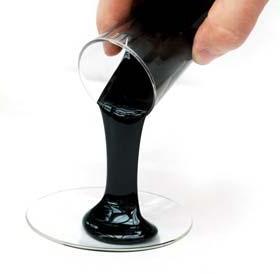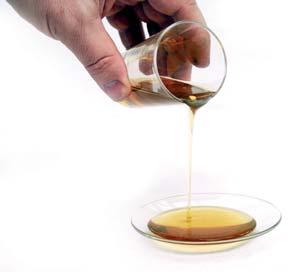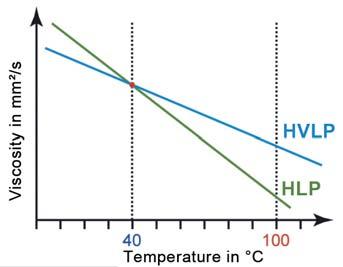
18 minute read
Viscosity –
The Single Most Important Physical Characteristic Of Any Oil
Viscosity is the most important physical characteristic of an oil. It plays the decisive role in the choice of accompanying lub ricant as it describes its fluid characteristics. It is also dependent on temperature and can be in fluenced by special additives. Since it can change when an oil is being used, it is one of the most fascinating and extensive topics in lubricant analytics. OELCHECK principally assesses viscosity in oil samples at 40°C and 100°C and calculates the viscosity index from this. Several modern devices have been installed in the laboratory just for determining viscosity alone.
Viscosity nowadays means a measurement of the fl owability of a lubricating oil or hydraulic fl uid. The higher the viscosity, the thicker the oil. And the lower the viscosity, the thinner the oil. Thin lubricating oils are mostly deemed to have low viscosity and thick lubricating oils are deemed to have high viscosity.


But viscosity isn’t just measured for lubricating oils or paints and adhesives. Nearly all physical media and foodstuffs have a speci fi c viscosity. The concept takes its name from the typically gooey sap that comes from mistletoe berries (viscum). Glue used to be extracted from the mistletoe for catching birds. “Viscous” therefore originally meant “sticky like birdlime”. The viscosity of this paste was, however, altered in Roman times, for example with honey. Whether thin or thick, the viscosity of a modern lubricant is accurately adjusted nowadays to suit its intended use. Viscosity itself is not a characteristic of quality.
A viscosity reading simply tells you how thick or thin an oil is. At the same time, however, it is the most decisive key fi gure for describing an oil’s capability to build a separating lubricating film between two moving parts. When a machine is started, the oil must not be to viscous because otherwise it will not reach the areas that need to be lubricated in time. Conversely, if it is too thin at the operating temperature, it will not be able to guarantee a suffi cient lubricating film to protect it from wear. If an oil is used as a hydraulic fluid, it must in turn demonstrate particular fluid behaviours in order to enable the desired power transmission.
If the wrong viscosity is chosen, the catastrophic consequences can be more drastic and occur faster than if the wrong type of oil is used. If, for example, an ISO VG 320 oil is used in a screw compressor which should be supplied with an ISO VG 32 oil, usually the damage will occur after just a few minutes. If the compressor is lubricated using the wrong type of oil, such as an HLP 32 hydraulic oil, then problems will only become apparent after a few thousand hours.
Viscosity: dynamic and kinematic
In physical terms, viscosity reflects the internal friction which ensues when neighbouring liquid layers are displaced. In highly viscous oils, these layers are bound together much more strongly and are therefore less moveable. In the case of dynamic or “true” viscosity, flow resistance within a liquid is measured. It is provided in data sheets or laboratory reports in mPas (millipascal-seconds) or cP (centipoise). For calculations, the uniform SI unit kg/m*s is used. The idea for the model is that the force exerted to displace a liquid, which is located between two plates arranged in parallel, is measured.
This measures the required torque. From that and also from the exact geometry of the rotational object used and the external geometry, the viscosity can be calculated based on the rotational speed.
Kinematic viscosity
Since it takes a high level of metrological effort to calculate dynamic viscosity, the practical kinematic viscosity calculation method was established. This describes the “viscosity-density ratio” and is expressed using the SI unit mm²/s or often the “centistoke” (cSt).
Top plate A, which rests on the liquid film, is moved with force F at a constant speed v parallel to the base plate. The liquid film, which is directly under the moving plate, sticks to it completely. Due to internal friction in the liquid, layers which are further away are displaced a bit further in the direction of movement. However, this displacement decreases in the direction of the “base plate” with each layer. In turn, the very bottom layer remains motionless as the film, stuck to the base plate. The model diagram shows the displaced positions of the layers at the end of the test. The following formula, which is dependent on the number of liquid layers (h), applies for dynamic viscosity:
Dynamic viscosity = shear stress (force F / moving plate A) / shear rate (speed v / liquid film thickness h).
Dynamic viscosity often used to be determined using falling ball viscometers. Nowadays, rotational viscometers are also used whereby an object is rotated in the oil of a liquid by a motor or a solenoid.
The principle of measuring kinematic viscosity is based on the time it takes an oil to fl ow through a de fined route of a capillary at a certain temperature using gravity. With the help of the capillary constant of the “viscometer”, kinematic viscosity is calculated based on the fl ow time. Kinematic viscosity is calculated by dividing dynamic viscosity by density. Dynamic viscosity is calculated by multiplying kinematic viscosity by density.
With these calculations, it is important to note that, prior to this, the density, which is usually indicated at 15°C for lubricants, must be converted for a density at 40°C or 100°C or the operating temperature (xx) according to the formula d xx = d15 - (xx -15)*0.00067.
Viscosity changes
Unlike water, which has almost the same fl owability between 0°C and 100°C, the viscosity of oil varies hugely according to temperature. In addition, operating pressure or factors, such as oxidation or impurities, also in fluence viscosity. Unfortunately, it gets even more complicated, because the fl owability of an oil does not change uniformly, i.e. linearly, with temperature.
Viscosity-temperature behaviour
When the temperature drops, an oil will always become thicker, i.e. will have a higher viscosity. When the solidifying point is eventually reached, the oil will become so thick that it can no longer move at all. On the other hand, when the temperature increases, the viscosity drops considerably. The oil can become extremely thin. These temperature-dependent changes must be taken into account when choosing a lubricant. Particular care needs to be taken since viscosity-temperature behaviour depends on the type of oil. Even oils with the same viscosity at, for example, 40°C can behave totally differently at 0°C or 100°C.
A temperature-dependent viscosity change will not be linear but can be calculated “double logarithmically”. Temperature differences of, for example, 10°C do not lead to identical number jumps in viscosity changes. The viscosity index (VI), which is calculated with the aid of kinematic viscosity measured at 40°C and 100°C, is used to describe an oil’s viscosity-temperature behaviour. This parameter allows the viscosity behaviour of various oils to be better compared based on temperature. The calculation method described in ISO 2909 was developed approximately 60 years ago. In terms of the viscosity index, the worst mineral oils known at the time were awarded a VI of 0, and the mineral oils with the best viscosity-temperature behaviour were awarded a VI of 100. At the time, there were no synthetic or multigrade oils. Nowadays, viscosity can be influenced by so-called VI improvers or synthetic oils to such an extent that the viscosity index now extends far beyond 100. The following standard values illustrate how high the viscosity index can be taken by modern oils:

Oil or fluid type Viscosity Index
Mineral oil ~ 95 - 105
Multigrade oil ~ 140 - 200
PAO oil ~ 135 - 160
Ester ~ 140 - 190
Vegetable oil ~ 195 - 210
Glycol ~ 200 - 220
Silicone oil ~ 205 - 400
A simple and widely-used method for visualising viscosity-temperature behaviour is the viscositytemperature diagram (VT diagram) according to Ubbelohde/Walther. Using the mathematical conversion (double logarithmical calculation), VT behaviour can be approximated to such a degree using a straight line through two points (usually at 40°C und 100°C), that viscosity at all other temperatures can be read from the diagram. Different fields of application can be illustrated using the VT diagram. HLVP oil with a higher viscosity index can, for example, cover a broader temperature range.
Viscosity changes in oil applications
With regards to oil changes, the most important parameter in used oil analyses is the consideration of viscosity changes. The viscosity of an oil can change for reasons other than just temperature and pressure. If the viscosity of a sample differs from the initial values of the fresh oil or the reference of the previous analysis, the causes may be as follows:
Increase in viscosity
- During operations, the oil has absorbed oxygen on account of the temperature and has therefore been oxidised.
Viscosity-pressure behaviour
Oils also become thicker with increased pressure. Viscosity-pressure behaviour is also a lubricantspeci fi c parameter which can however, for the most part, be neglected since, at pressures below 400 bar, it is virtually insigni fi cant. The change in viscosity due to an increase in pressure of 100 bar is disproportionately less than that due to an increase in temperature of 10°C. Designers of highperformance hydraulic systems and components always consider the in fluence that pressure has on viscosity whilst also allowing for the temperature in fluence which occurs simultaneously.

- Oxidation inhibitors, ageing-delaying additives have decomposed.
- Ageing and oxidation products, such as acids and oil-insoluble components have formed.
- Varnish-like deposits, such as resin and sludge, have built up.
- Soot, dust, water or residues from alternative fuels are contaminating the oil.
- The wrong oil was used or re filled.
Decrease in viscosity
- VI improvers, additives for improving the viscosity index, were not shear-stable and have decomposed.
- Unburned fuel (poor combustion) has diluted the oil.
- An oil which was too thin or the wrong type of oil was used or re filled.
- The system was cleaned with a thin flushing oil prior to being filled. Flushing oil residues have got mixed in.
Viscosity classes or groups
Amongst other things, lubricants are tasked with protecting the surfaces of pairs of moving parts against wear by building a resilient lubricating film. There is the positive effect that, with traditional lubricating oils, the viscosity in the lubricating film is increased to such an extent on account of the prevailing pressure on it that the surfaces are kept apart. In metrological terms, the viscosity of a lubricating oil, which has been changed on account of high pressure, is very dif fi cult to determine. Only a handful of institutes, such as the RWTH in Aachen, can also actually carry out such measurements.
Almost every oil denomination has a number, the so-called viscosity class for automotive oils or viscosity group for industrial oils. The groupings are a big help when it comes to choosing the viscosity for the “right-fit” oil. Just like a shoe size, a viscosity class simply represents a “value that fits”. Just like when you’re buying shoes and you have to make it clear what you need them for, for example walking, dancing, running, etc., when you’re considering lubricants you have to know what machine they will be used in and what operating conditions they will be exposed to.
The SAE classes for engine oils, defined by the American Society of Automotive Engineers, were introduced back in 1911 practically all around the globe.
Prior to 1950, in Germany, industrial lubricants were distinguished from each other on the basis of their flowability at 50°C according to Engler degrees. By defining the ISO VG viscosity groups, in 1975 the International Standards Organization (ISO), together with other leading institutions, came up with a helpful tool for selecting industrial lubricants based on kinetic viscosity at 40°C (instead of 50°C in Europe or 100°F in USA).
A comparison of viscosities according to ISO VG (at 40°C) and SAE (at 100°C or for winter oils in the bottom temperature range) is limited since the thresholds of viscosity classes are not congruent. It is particularly dif fi cult in the case of multigrade oils.
ISO viscosity groups for industrial oils
The system covers 18 viscosity ranges. In accordance with DIN 51 519, the minimum and maximum kinematic viscosity for each class is de fi ned in mm²/s at 40°C. The thresholds for each class account for a ± 10% deviation from the midpoint viscosity. No VI or second viscosity is provided. Therefore, the ISO VG cannot make any claims about viscosity-temperature behaviour. With the exception of multigrade hydraulic oils, speci fi ed in DIN 51524-3, the multigrade characteristic is of secondary importance in the fi eld of industry not least because industrial machines are operated at a constant temperature.
Automotive gear oils were grouped by the organisation SAE according to the same system as automotive engine oils. It can, however, be misleading if the same column of fi gures has an extremely viscous SAE 60 engine oil and then extremely thin SAE 75W or 80W gear oils, in accordance with SAE J-306/DIN 51512. The classi fi cation for gear oils with their particularly high numerical values cannot therefore be seen as a simple continuation of the engine oil classi fi cation. An SAE 80 gear oil is also not twice as “thick” as an SAE 40 engine oil. However, gear oils that are suitable for use at low temperatures are also denoted with a W. The table for gear oils wasn’t updated until the end of 2005 with classes SAE 110 and SAE 190. It became necessary to do so on account of the broad viscosity range of the “old” SAE 90 (18.5 cSt up to <24 cSt at 100° C) and the old SAE 140 (24 cSt up to < 41 cSt at 100° C). The range meant that the actual viscosity of the different oils could deviate heavily although the oils were grouped in the same SAE class. The new, more tightly de fi ned, viscosity classes SAE 110 and 190 increase the accuracy of viscosity speci fi cations for gear manufacturers.
the change in viscosity value can only be assessed in context through a change in the viscosity index. Our laboratory operates six baths (3 x 40°C and 3 x 100°C), each with 4 capillaries, in order to regularly measure kinematic viscosity. These ISL Houillon viscometers have been retro fi tted with synchronous robots. They take exact doses of less than 1 ml of oil per capillary and do this for over 1,000 samples a day.
SAE classes for automotive oils
Previously, engine oils were changed according to the time of year. In accordance with SAE J-300/ DIN 51511, oils for the automotive industry still have a W in their name if they are designed for use at low temperatures.
Thanks to appropriate base oils and the addition of modern viscosity index improvers, multigrade oils such as 5W-30 meet the viscosity class criteria of a W-oil (with the required low-temperature viscosity) as well as a high-temperature requirement (with an indication of minimum viscosity at 100°C).
Viscosity and the VI in the OELCHECK laboratory

The determining of kinematic viscosity at 40°C and 100°C as well as the resulting standardised VI calculation are fi xed components of the scope of analysis for each and every OELCHECK analysis set. In contrast to many other service laboratories, as a matter of course, we take measurements at both of these two temperatures. This is because
Please note:
We normally determine dynamic viscosity only in exceptional cases. If an oil is so heavily contaminated that we suspect that the capillaries with diameters of approx. 0.1 mm are clogged, we use a Nametre Viscoliner 1710 to investigate dynamic viscosity at room temperature and at approx. 70°C and with the help of the temperature-corrected density we calculate kinematic viscosity at 40°C and 100°C. That way, it is possible to observe a trend even in heavily contaminated liquids.
However, a designer sometimes needs more than just the viscosity-temperature curve for an oil, as displayed in a graph. In order to design bearings, lubrication holes, pump pressures or tooth widths, for example, they often need the actual dynamic viscosity at precisely defined upper and lower threshold temperatures. With the Anton Paar Rheometer Physica MCR 301 we therefore create a precise viscosity-temperature profile for the lubricant and measure its viscosity at intervals of 10°C within the temperature range of -30°C to +110°C.
Even if viscosity is not a direct characteristic of quality, it represents one of the most important key fi gures of an oil.
For every oil sample, OELCHECK assesses viscosity at 40°C and 100°C and calculates the viscosity index from that. That’s the only way that conclusions can be drawn on the causes of viscosity changes with suf fi cient accuracy.
OELCHECK laboratory investigations can ascertain whether:
- an oil with the prescribed viscosity was actually used.
- it is a synthetic, mineral, single-grade or multigrade oil.
- a viscosity change has taken place, which was caused, for example, by: oils being blended, contamination, decomposition of viscosity index improvers, dilution due to unburned fuel, oil ageing and a viscosity increase often associated with that.
If the viscosity deviates too heavily from the value of the fresh oil or the previous sample, we urgently recommend carrying out an oil change. Depending on the oil type, what the oil is used for and its operating time, our warning values for viscosity changes are between 5% and 15%, but are even lower in the case of some sensitive applications (turbine lubrication and oil circulation systems).
We have been using OELCHECK lubricant analyses for several years now and couldn’t manage without them. But why do you not indicate any “limit values” in your laboratory reports, in particular for wear metals? You only give the values for the current sample and previous investigations. If limit values were also provided, we could draw conclusions on the condition of the oil or the machine even faster ourselves and with greater accuracy.
OELCHECK:
The suggestion to provid e the limit, threshold and warning values for wear metals or even for lubricant additives was a hot topic in our last customer survey. But unfortunately we cannot grant this wish as limit values, which are independent of time, do not reflect application-specific scenarios. In conclusion, every machine, with its own operational conditions, needs to be considered on an individual basis. For this, not only do we have to take into account the machine type, the actual lubricant used, its maintenance and the amount to be filled – above all its operating time as well as environmental conditions influence threshold limit consideration. In the case of complex systems, this is often even more complicated. This is because some manufacturers purchase components from alternate suppliers which may have the same features but are made from different materials. Also, if partial-flow filters have been installed, large amounts of oil have been refilled or additives have been added retrospectively, fixed limit values are no longer helpful.
Limit values with corresponding limitations are published only in a handful of cases by machine and engine manufacturers. Therefore, with the help of our own database, which
QUESTION TIME:
contains over two million samples, we decided to make the complex topic more transparent for our diagnosis engineers. Meanwhile, for assessing the examined samples, we use internal wear threshold values for over 150,000 different machines. In the event of a deviation or change in a single component of a device, we create a new database. For this speci fi c machine type, however, we won’t have threshold values until we have conducted at least 50 analyses for the same or a similar type of machine. Because even though such detailed knowledge on limits for wear metals may be available, it is not suf fi cient for assessing an actual sample. This is where our know-how comes into play because all values must also be considered together as a whole. A diagnosis that is based solely on comparing laboratory data that has just been established with limit values can quickly become misleading. Values will look different if they are assessed after 20, 200, 2,000 or 20,000 hours. In order to rule out the time-related risk, for example, we do not publish threshold values as a matter of principle.
How complex the contexts can be overall is illustrated in the following examples:
Not all elements and metals detected in a sample necessarily suggest wear. Some (e.g. copper) can also be additives that are found in lubricants. First of all, a comparison of the used oil values with the additives from the fresh oil, together with the IR spectrum, gives an indication of additive decomposition. Perhaps just a single active component from the whole additive package changed by forming a new type of bond with wear particles.
It is essential that even the threshold limits typical for impurities for silicon and water are examined. For example, if silicon is detected in the oil, it usually means that the oil has been contaminated with dust. Silicone is also
ÖlChecker – a magazine from OELCHECK GmbH
Kerschelweg 28 · 83098 Brannenburg · Germany info@oelcheck.de · www.oelcheck.de
All rights reserved. Reproduction without permission prohibited.
Concept and text: Astrid Hackländer, Marketing & PR, A-4600 Thalheim www.astridhacklaender.com
Layout and design: Agentur Segel Setzen, Petra Bots, www.segel-setzen.com
Photos: OELCHECK GmbH · Prokon · August Storm specifically added as an anti-foaming additive to almost all oils. In new or overhauled engines, silicon can be a component of silicone-containing assembly pastes or sealants. Additionally, it is an alloy component of aluminium and therefore possibly a wear element in full-aluminium engines. How can a threshold value, which needs to be generally applicable, be created as a benchmark here if all these possible contexts are not taken into account?
Too much water in the oil can, for example, promote corrosion, cavitation or oil oxidation. Even mineral-oil-based fresh oil has 50 to 500 ppm water, depending on oil type or production plant to various extents and with varying relative humidity. Depending on their intended purpose, oils also deliberately possess demulsifying or emulsifying characteristics. The level at which water content becomes risky depends on the oil type, its performance requirements and its operating time.
Limit values, which you may get from the OEM or lubricant manufacturer, are only useful to a certain degree in our diagnoses. If at all, they display the values from different perspectives. What is most important to the manufacturer in this case is the warranty, for the oil manufacturer it’s the oil service life that’s important, and a lubricant laboratory like OELCHECK mainly considers the values from a condition monitoring perspective. Warning and threshold limits also play a role but you achieve a consistently positive effect, primarily, with our trend analyses. If we analyse an oil, which is used in a machine, on a regular basis and over a long period of time, we can quickly and accurately detect the tiniest of deviations and specifically warn you before any dangerous levels are exceeded.
OELCHECK will also answer your questions on tribology and lubricant analyses.
Send us your questions by e-mail (info@oelcheck.de) or by fax (+49 8034/9047-47).
Dr Lutz Lindemann
Keynote speaker at the OilDoc Conference and Exhibition
Our keynote speaker at the OilDoc Conference and Exhibtion 2013 will be Dr Lutz Lindemann, member of the board for FUCHS PETROLUB AG. The title of his opening speech at our conference will be: “Lubricant development in the context of new raw materials”.
Dr Lindemann has thereby chosen a very hot topic. Tailor-made new fully synthetic base oils and sophisticated active agent combinations are opening up a plethora of new prospects in the targeted development of lubricants. However, contexts and interactions are extremely complex. A lubricant with a high concentration of additives is more than just an agent between two moving parts – it’s an important design element. A lot of machine and engine technology used today can be used only with a specially formulated lubricant. One such example is engine oils which have been developed for use in modern vehicle engines. Catalytic converters and soot particle filters used in such engines are able to meet the ever more demanding emission standards only by using Low SAPS engine oils.
With our guidelines you won’t miss any of the many highlights!
More than 90 presentations and a huge trade show wait! Top speakers from all over the whole world have submitted their suggest ions for topics. An internatio nal committee has compiled an ambitious programme from the huge number of top-class presentations. It is so eclectic and interesting that you should already be planning ahead which talks are going to be particularly interesting for you.
To ensure that you don’t miss any of the highlights, our guidelines will recommend a schedule just for you. You will find guidelines for the following key topics under the menu item “Guidelines” at www.oildoc-conference.de: power generation, gears, hydraulics, maintenance, lubricants, lubricant analytics, tribology, combustion engines and wind turbines.
Dr Lutz Lindemann is a graduate chemist and a leading figure in the international mineral oil industry. His career began in 1988 at Mobil Oil AG, in Hamburg. In 1995 he became a senior advisor/project manager at Berger & Partner in Stuttgart, and then from 1996 to 1998 was a product manager at DEA Mineralöl AG, in Hamburg. From 1998 to 2008 Dr Lutz Lindemann was a member of the group management team for FUCHS PETROLUB AG with regional responsibility for Germany, Eastern Europe (incl. Russia) and Scandinavia and was also chairman of the executive board of FUCHS EUROPE SCHMIERSTOFFE GmbH, in Mannheim, the largest subsidiary company of FUCHS PETROLUB AG. Since January 2009 Dr Lutz Lindemann has been a member of the board for FUCHS PETROLUB AG and is responsible for technology, supply chain and OEMs.
Highlights of the Summer 2012 edition:
OilDoc Conference and Exhibition 2013

Seminars & symposia in autumn/winter 2012
Intensive lubricant specialist seminar


OilDoc at IHA’s maintenance and service conferences
Customised seminars and consultation service for REpower




